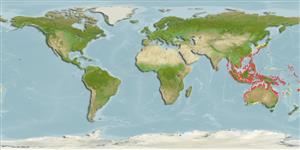Issue
Regarded as nomen dubium (unavailable) in Randall et al., 2014 (Ref. 95583:21)
Environment: milieu / climate zone / depth range / distribution range
Ecologia
marino; salmastro associati a barriera corallina. Tropical
Indo-West Pacific: southwest Sumatra to Bali Strait, and Malaysia (Ref. 5756).
Size / Peso / Age
Maturity: Lm ? range ? - ? cm
Max length : 15.0 cm NG maschio/sesso non determinato; (Ref. 27550)
Inhabits coral reefs and rocky areas (Ref. 27550). Enters estuaries (Ref. 27550). Feeds on crustaceans and polychaete worms (Ref. 27550).
Life cycle and mating behavior
Maturità | Riproduzione | Deposizione | Uova | Fecundity | Larve
Gloerfelt-Tarp, T. and P.J. Kailola, 1984. Trawled fishes of southern Indonesia and northwestern Australia. Australian Development Assistance Bureau, Australia, Directorate General of Fishes, Indonesia, and German Agency for Technical Cooperation, Federal Republic of Germany. 407 p. (Ref. 5978)
IUCN Red List Status (Ref. 130435: Version 2024-1)
Threat to humans
Harmless
Human uses
Strumenti
Special reports
Download XML
Fonti Internet
Estimates based on models
Preferred temperature (Ref.
123201): 27 - 29.3, mean 28.8 °C (based on 1850 cells).
Phylogenetic diversity index (Ref.
82804): PD
50 = 0.5000 [Uniqueness, from 0.5 = low to 2.0 = high].
Bayesian length-weight: a=0.01380 (0.00591 - 0.03225), b=3.02 (2.83 - 3.21), in cm total length, based on LWR estimates for this Genus-body shape (Ref.
93245).
Trophic level (Ref.
69278): 3.3 ±0.38 se; based on food items.
Resilienza (Ref.
120179): Alto, tempo minimo di raddoppiamento della popolazione meno di 15 mesi (Preliminary K or Fecundity.).
Fishing Vulnerability (Ref.
59153): Low vulnerability (10 of 100).
Nutrients (Ref.
124155): Calcium = 91.6 [46.4, 150.3] mg/100g; Iron = 0.688 [0.418, 1.148] mg/100g; Protein = 18.8 [17.7, 19.9] %; Omega3 = 0.121 [0.073, 0.202] g/100g; Selenium = 21.7 [11.6, 40.8] μg/100g; VitaminA = 74.8 [21.9, 250.4] μg/100g; Zinc = 1.66 [1.12, 2.39] mg/100g (wet weight);
